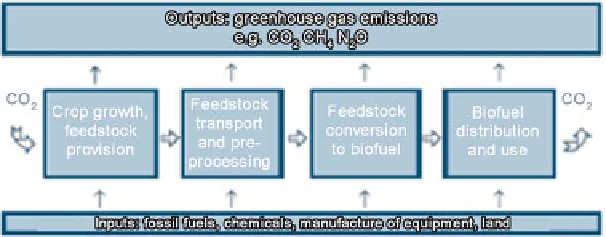Environmental Engineering Reference
In-Depth Information
Fig. 8.2
Greenhouse gas emissions from production and utilisation of biofuels
Source: Sustainable biofuels: prospects and challenges, The Royal Society. Policy document 01/08,
ISBN 978 0 85403 662 2. Reproduced with permission of the Royal Society.
need to be taken into account in order to contribute to a sustainable and energy
secure future.
In this contribution, we aim to provide a general overview of the state of the art
in the production and potential of biofuels for transport. Several technologies have
been disclosed for the preparation on biofuels. Depending on the technology and
the feedstock, we can classify the biofuels into different generations from simpler
and conventional technologies and feedstocks (1st generation) to more advanced
technologies (2nd generation and a potential 3rd generation in the horizon) in the
so-called
biofuels ladder
.
8.2 Biofuels: Processes and Technologies
8.2.1 First Generation Biofuels
The first generation biofuels referred to biofuels manufactured from readily avail-
able energy crops including sugar, starch and oil crops (
edible feedstocks
)using
conventional technologies. The most common first generation biofuels are biodiesel
and bioethanol. Some other biofuels in this category including biofuels integrating
glycerol, biofuels from catalytic cracking and biobutanol will also be briefly dis-
cussed. The various biofuels will be grouped according to the technology employed
for their preparation. These are
chemical
and
biological
conversion.
8.2.1.1 Biofuels Produced by Chemical Conversion
Biodiesel
First generation biodiesel is currently the most common biofuel in Europe. It
remains in the political and economic arena and is playing a part in the biofuels
expanding process as the awareness alternative fuel spreads through the conscious-
ness of the general public. Only in 2007, 19 biodiesel plants in the new EU member

